
Iris lacustris, the dwarf lake iris, is a plant species in the genus Iris, subgenus Limniris and in the section Lophiris. It is a rhizomatous, beardless perennial plant, native to the Great Lakes region of eastern North America. It has lavender blue or violet-blue flowers, a very short stem and long fan-like green leaves. It is cultivated as an ornamental plant in temperate regions. It is closely related to Iris cristata.

Iris cristata is a species in the genus Iris, and is part of the subgenus of Limniris. It is a rhizomatous perennial plant, endemic to the eastern United States. It has pale lavender flowers with a white patch and orange or yellow crest. It is a close relative to Iris lacustris, the only other crested iris native to North America. It is cultivated as an ornamental plant in temperate regions.

Iris confusa (; also known as the bamboo iris is a species of iris. It is also in the subgenus Limniris and in the section Lophiris. It is a rhizomatous perennial plant, native to Western China. It has flowers which range from white to a soft lavender or pale blue in colour, with orange-yellow crests and purple dots. The plant's broad, shiny leaves are attached to bamboo-like stems. It is cultivated as an ornamental plant in temperate regions.

Iris tectorum is a plant species in the genus Iris, it is also in the subgenus Limniris. It is a rhizomatous perennial. It is native of China, Korea and Burma, with lavender-blue, bluish-violet, purple-blue, blue-lilac or sky blue flowers. There is a white form as well. It is a compact plant and is cultivated as an ornamental plant in temperate regions of the world.
Iris tenuis is a plant species in the genus Iris, subgenus Limniris. It is a rhizomatous perennial, endemic to Clackamas County, Oregon. The flowers are white, pale blue or lilac, with a yellow or golden low dissected crest and pale green leaves. It is cultivated as an ornamental plant in temperate regions.
Iris songarica is a beardless iris in the genus Iris, in the subgenus Limniris and in the series Tenuifoliae of the genus. It is a rhizomatous herbaceous perennial, from Central Asia, located in Afghanistan, Pakistan, Iran, Kazakhstan, Tajikistan, Turkmenistan and Uzbekistan. It has long strap-like leaves, a long stem and 2–3 flowers in shades of violet, dark blue, to lavender blue.
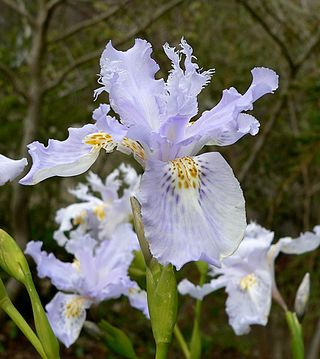
Iris wattii is a plant species in the genus Iris, it is also in the subgenus Limniris and the section Lophiris. It is a rhizomatous perennial plant. It is native to China, Burma and India, it has lavender or light blue flowers. It is also known as 'Bamboo Iris'. It is cultivated as an ornamental plant in temperate regions.
Iris falcifolia is a plant species in the genus Iris, it is also in the subgenus Iris and in the section Hexapogon. It is a rhizomatous perennial, from Uzbekistan, Kazakhstan, Afghanistan, Iran and Pakistan. It is a small plant, with sickle-shaped greyish-green leaves, lilac-violet flowers and darker veining, and a white or yellow beard. It is cultivated as an ornamental plant in dry, temperate regions.
Iris longiscapa is a plant species in the genus Iris, it is also in the subgenus Iris and in the section Hexapogon. It is a rhizomatous perennial from the deserts of Kazakhstan, Tajikistan, Turkmenistan and Uzbekistan. They have grass-like leaves and lilac-violet or blue-purple flowers on a tall slender stem.
Iris mandshurica is a species in the genus Iris; it is also in the subgenus of Iris and in the Psammiris section. It is a rhizomatous perennial, it is found in Russia, China, and Korea. It has green sword-like leaves, smooth green stem and yellow flowers, with yellow-purple veining and a yellow beard. It is cultivated as an ornamental plant in temperate regions.
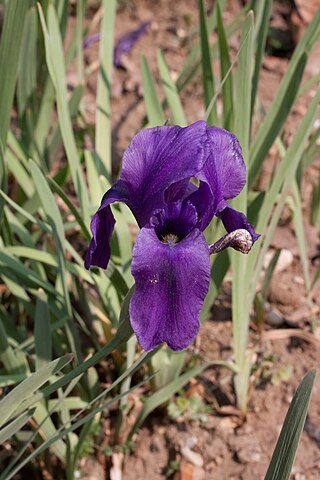
Iris hoogiana is a plant species in the genus Iris, it is also in the subgenus Iris and in the section Regelia. It is a rhizomatous perennial, from the grassy mountainsides of Turkestan. It has long green leaves, which are slightly purple at the base, and a long slender flowering stem. The flowers are blue, ranging from sky-blue to lavender blue and blue purple. It has orange or yellow beards. It is cultivated as an ornamental plant in temperate regions.
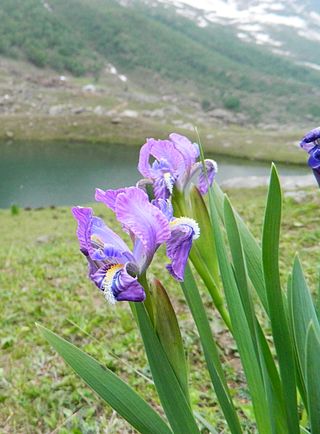
Iris hookeriana is a plant species in the genus Iris, it is also in the subgenus Iris and in the section Pseudoregelia. It is a rhizomatous perennial, from the Himalayan mountains of India and Pakistan. It has long pale green or yellow green leaves, long slender stem and fragrant blue, purple or lilac flowers, that are mottled with a darker colour. It is cultivated as an ornamental plant in temperate regions.
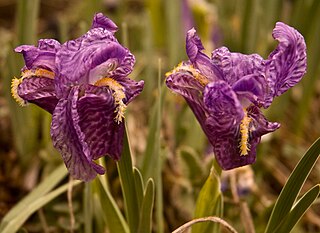
Iris kemaonensis, the Kumaon iris, is a plant species in the genus Iris, it is also in the subgenus Iris and in the section Pseudoregelia. It is a rhizomatous perennial, from Tibetan China, Bhutan, India, Kashmir and Nepal. It has light green or yellowish green leaves, that extend after flowering time. It has a short stem, 1–2 fragrant flowers that are purple, lilac, lilac-purple or pale purple. They also have darker coloured blotches or spots. It is cultivated as an ornamental plant in temperate regions. It is often known as Iris kumaonensis, due to a publishing error.
Iris sikkimensis is a plant species in the genus Iris, it is also in the subgenus Iris and in the section Pseudoregelia. It is a rhizomatous perennial, from Sikkim. It has pale green or light green thin leaves, slender stem, 2 or 3 lilac or purple flowers, with a white beard with orange tips. It is thought to be a hybrid of Iris hookeriana and Iris kumaonensis.
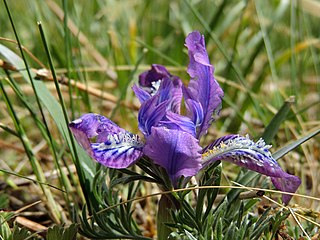
Iris tigridia is a plant species in the genus Iris; it is also in the subgenus Iris and in the section Pseudoregelia. It is a rhizomatous perennial, from Kazakhstan, Russia, Mongolia and China. It has dark green or greyish green, grass-like leaves, a short slender stem and a single flowers that are either violet, dark blue, blue-purple, dark purple, mauve, lilac, lavender, or light purple. It is cultivated as an ornamental plant in temperate regions.
Iris cypriana is a plant species in the genus Iris, it is also in the subgenus Iris. It is a rhizomatous perennial, from Cyprus. It has narrow, glaucous and evergreen leaves, tall slender stem, with 2–3 branches, and 1–3 large flowers in lavender, lilac, red-lilac, to dark purple shades. It is cultivated as an ornamental plant in temperate regions. It is listed in some sources as a synonym of Iris germanica.

Iris scariosa is a plant species in the genus Iris; it is also in the subgenus Iris. It is a rhizomatous perennial from the mountainsides of Russia, Kazakhstan, Mongolia and China. It has sword-like, or sickle shaped, blue green or grey-green leaves, a short flowering stem, 3 or 4 membranous or semi-transparent flower bud leaves, 2 violet, reddish violet, lilac, blue-purple, or blue flowers in late spring, with yellow or white beards. It is cultivated as an ornamental plant in temperate regions. It was merged with another similar iris in the region, and Iris glaucescens became a synonym of Iris scariosa, before being divided into two separate species again. Although some sources still call it the main species, despite a slight colour difference.
Iris griffithii is a plant species in the genus Iris, it is also in the subgenus Iris. It is a rhizomatous perennial, from Afghanistan. It has short, sickle-shaped leaves, short green stem and purple flowers with white beards. Several specimens exist within herbaria around Europe, but it is rarely cultivated.
Iris hellenica is a plant species in the genus Iris and the subgenus Iris. It is a rhizomatous perennial, from Saitas Mountain, in the Peloponnese Region of Greece. It has grey-green, sickle-shaped leaves, a tall slender stem, 2–3 white, lavender-blue, lilac or purple flowers and orange/purple beards. It was thought once to be a hybrid species of Iris germanica which also grows in the same area, before being separated into 2 species. It has only recently been published and is rarely cultivated as an ornamental plant in temperate regions.

Iris kashmiriana is a plant species in the genus Iris, it is also in the subgenus Iris. It is a rhizomatous perennial, from Kashmir, India. It has straight, sword-shaped, glaucous leaves, tall, thick stem with up 2 short branches, which hold 2–3 flowers, which can be white, cream or pale blue, lilac, lavender or blue-purple. It is cultivated as an ornamental plant in temperate regions, although in Kashmir, it is also planted on graves.














